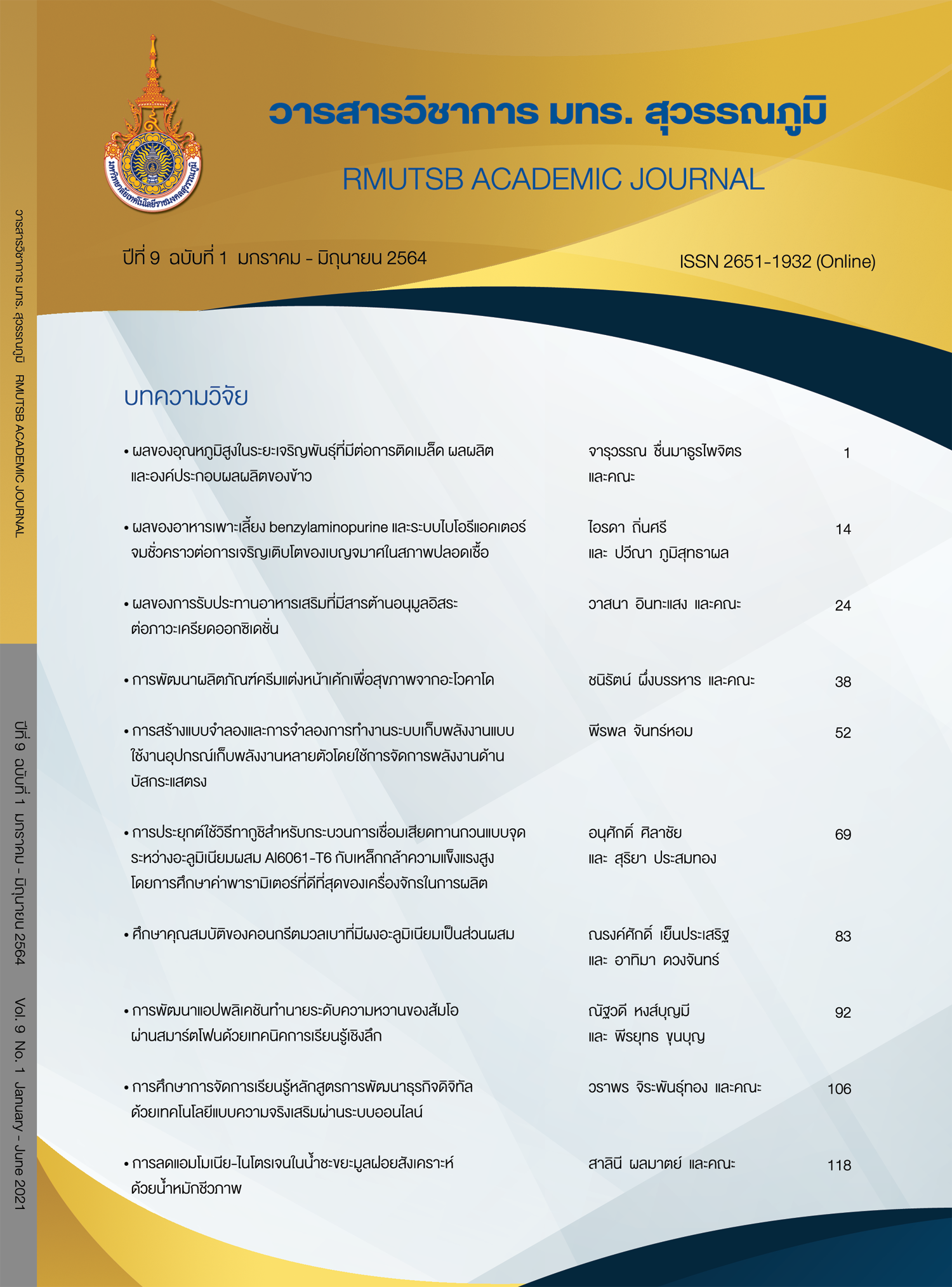Effects of culture medium, benzylaminopurine and temporary immersion bioreactor system on growth of chrysanthemum under aseptic condition
Main Article Content
Abstract
In this research, the factors affecting on growth of chrysanthemum (WG) cultured under aseptic condition were studied. The single nodal explants were cultured on a semi-solid medium including ¼ MS, ½ MS and MS added with cytokinin 6-benzylaminopurine (BAP) at 0, 0.25, 0.50, and 1.00 mg/L for a period of 8 weeks. It was found that all treatments produced only 1 new shoot per explant, and number of nodes per shoot were not statistically different among treatments. The ½ MS medium without growth regulator showed the highest shoot length, number of nodes per shoot and shoot fresh weight at 7.36 cm, 7.40 nodes, and 333.07 mg, respectively. Furthermore, the effect of different culturing systems was compared. The single nodal explants were cultured using ½ MS medium without a growth regulator combined with the twin-flasks temporary immersion bioreactor (TIB) system with liquid medium feeding every 24 h for 4, 5, and 6 min each time, and compared with the semi-solid medium. The results showed that after a period of 8 weeks, the feeding liquid medium every 24 h for 5 min each time was suitable for cultivation. This feeding condition gave the highest number of shoots per explant, number of nodes per shoot, and shoot fresh weight at 1.48 shoots, 10.10 nodes, and 841.67 mg, respectively, which were increased 1.40, 1.26 and 2.53 times, respectively compared to those of semi-solid medium. However, the hyperhydricity (50%) was found as abnormal characteristic when liquid medium was fed every 24 h for 6 min each time.
Article Details
Published manuscript are the rights of their original owners and RMUTSB Academic Journal. The manuscript content belongs to the authors' idea, it is not the opinion of the journal's committee and not the responsibility of Rajamangala University of Technology Suvarnabhumi
References
Albarrán, J., Bertrand, B., Lartaud, M., & Etienne, H. (2005). Cycle characteristics in a temporary immersion bioreactor affect regeneration, morphology, water and mineral status of coffee (Coffea arabica) somatic embryos. Plant Cell, Tissue and Organ Culture, 81(1), 27-36.
Escalona, M., Lorenzo, J. C., González, B., Daquinta, M., González, J. L., Desjardins, Y., & Borroto, C. G. (1999). Pineapple (Ananas comosus L. Merr) micropropagation in temporary immersion systems. Plant Cell Reports, 18(9), 743-748.
Georgieva, L., Tsvetkov, I., Georgieva, M., & Kondakova, V. (2016). New protocol for in vitro propagation of berry plants by TIS bioreactor. Bulgarian Journal of Agricultural Science, 22(5), 745-751.
Gutiérrez, L. G., López-Franco, R., & Morales-Pinzón, T. (2016). Micropropagation of Guadua angustifolia Kunth (Poaceae) using a temporary immersion system RITA®. African Journal of Biotechnology, 15(28), 1503-1510.
Hahn, E. J., Lee, Y. B., & Ahn, C. H. (1996). A new method on mass-production of micropropagated chrysanthemum plants using microponic system in plant factory. Acta Horticulturae, 440, 527-532.
Iamfaeng, S. (1989). Chrysanthemum breeding by plant tissue culture method (Master's thesis). Kasetsart University, Bangkok. (in Thai)
Imtiaz, M., Khattak, A. M., Khan, M. A., Jalal, F., Hussain, S., Said, F., & Bo, H. (2019). Rapid in-vitro propagation of Chrysanthemum morifolium through shoot bud explants. Pakistan Journal of Botany, 51(3), 1093-1098.
Jiménez, E., Pérez, N., De Feria, M., Barbón, R., Capote, A., Chávez, M., & Pérez, J. C. (1999). Improved production of potato microtubers using a temporary immersion system. Plant Cell, Tissue and Organ Culture, 59(1), 19-23.
Koarapatchaikol, K., & Rugtham, L. (2015). In vitro clonal propagation of ivory [Wrightia arborea (Dennst.) Mabb.]. Thai Journal of Science and Technology, 23(5)(Suppl.), 833-845. (in Thai)
Lindiro, C., Kahia, J., Asiimwe, T., Mushimiyimana, I., Waweru, B., Kouassi, M., & Sallah, Y. P. (2013). In vitro regeneration of pyrethrum (Chrysanthemum cinerariaefolium) plantlets from nodal explants of in vitro raised plantlets. International Journal of Application or Innovation in Engineering & Management, 2(7), 207-213.
Renau-Morata, B., Nebauer, S. G., Arrillaga, I., & Segura, J. (2005). Assessments of somaclonal variation in micropropagated shoots of Cedrus: consequences of axillary bud breaking. Tree Genetics & Genomes, 1(1), 3-10.
Ruta, C., De Mastro, G., Ancona, S., Tagarelli, A., De Cillis, F., Benelli, C., & Lambardi, M. (2020). Large-scale plant production of Lycium barbarum L. by liquid culture in temporary immersion system and possible application to the synthesis of bioactive substance. Plants, 9(7), 844.
Saosinad, W, (2013). Appropriate medium for Dendranthemum grandiflora ‘MUM 13’ micropropagation in temporary immersion bioreactor compared to solid medium (Bachelor’s thesis). Maejo University, Chiang Mai. (in Thai)
Sumyo, S., & Adthalungrong, A. (2020). Chrysanthemum production situation. Retrieved 5 November 2020, from http://www.doa.go.th/hort/wp-content (in Thai)
Teisson, C., & Alvard, D. (1995). A new concept of plant in vitro cultivation liquid medium: temporary immersion. In Current Issues in Plant Molecular and Cellular Biology (pp. 105-110). Dordrecht: Springer.
Waseem, K., Jilani, M. S., Khan, M. S., Kiran, M., & Khan, G. (2011). Efficient in vitro regeneration of chrysanthemum (Chrysanthemum morifolium L.) plantlets from nodal segments. African Journal of Biotechnology, 10(8), 1477-1484.
Wu, R. Z., Chakrabarty, D., Hahn, E. J., & Paek, K. Y. (2007). Micropropagation of an endangered jewel orchid (Anoectochilus formosanus) using bioreactor system. Horticulture Environment and Biotechnology, 48(6), 376-380.
Yesmin, S., Hashem, A., Das, K. C., Hasan, M. M., & Islam, M. S. (2014). Efficient in vitro regeneration of chrysanthemum (Chrysanthemum morifolium Ramat.) through nodal explant culture. Nuclear Science and Applications, 23(1&2), 47-50.


